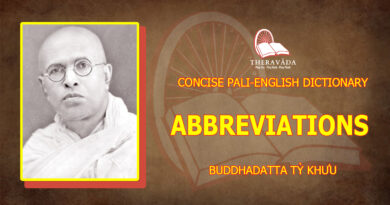BEGINNINGS: THE PALI SUTTAS – PART VI: THE FIRST COUNCIL
BEGINNINGS: THE PALI SUTTAS – PART VI: THE FIRST COUNCIL
“Come, friends: let us recite the Teaching and the Discipline before what is not the Teaching shines forth and the Teaching is put aside, before what is not the Discipline shines forth and the Discipline is put aside, before those who speak what is not the Teaching become strong and those who speak what is the Teaching become weak, before those who speak what is not the Discipline become strong and those who speak what is the Discipline become weak.”[23]
Thus, a few months after the Buddha’s decease a meeting now known as the First Council was held in the hills outside of Rajagaha (modern Rajgir, in Bihar) in order to put the Vinaya and the Suttas into a formal structure for the sake of those who would come later. Venerable Upali, who had gone forth at the same time as Venerable Ananda, was designated responsible for the Vinaya, as was Venerable Ananda for the Suttas. The account of their stewardships consists of but a few lines of reportage, probably edited long after the event — most likely together with the account of the Second Council, the report of which seems to be much more contemporaneous with its subject matter.
The evidence is twofold. First, we would expect the Culavagga to have, if not fewer, at least not more Khandhakas than the Mahavagga. In the Suttas we often encounter Maha/Cula pairs, and the Maha is invariably the longer. At any rate the Tenth Khandhaka of the Culavagga is concerned with the nuns. It would be inconsistent with attitudes displayed elsewhere in the texts for the nuns’ disciplinary matters to be placed ahead of the monks’ concerns, particularly at such an important convocation as the Council. Therefore, the account of the Councils must have been appended at a time when the Vinaya was already considered closed to interpolations. Indeed, the account of the Councils was almost certainly the final addition to the Vinaya texts.
Second, it is said in Khandhaka XI that Venerable Ananda recited the five Nikayas. Therefore the account could not have been edited until a time when the five Nikayas actually existed. Since the Suttas never refer to themselves as consisting of Nikayas at all, let alone as five, if we were to assume the account to be contemporary, we would be forced to suppose that this classification came into being quite dramatically. It is more reasonable to suppose that a body of material existed which, though not formally included in the First Council compilation, adhered to it as supplementary matter; that that material must have included an account of the Council itself; and that it, as well as certain other materials, eventually came to be included in the Canon before the Canon itself was regarded as closed. The account was included at a time when the five Nikayas already existed as formally organized bodies of texts, but probably was codified quite soon after, for the specification of the number five suggests an attempt to legitimize the last of them, the Khuddaka Nikaya.
Be that as it may, it is not difficult, despite the brevity of the reportage, to imagine what must have taken place. The Council was no mere recitation of texts: that had been going on for forty-five years and did not require a special assembly. The Council’s aim must have been two-fold:
1) To decide what, out of the vast store of material at hand, should be given the protection of formal organization; and
2) To set up a mechanism to preserve this material.
Obviously it couldn’t all be saved. Not only were there the Buddha’s discourses, all 82,000 of them,[24] but also the discourses of many other monks, some of them learned, wise, enlightened, liberated. Some of the discourses were duplicates — the monks from Savatthi remembering the Buddha saying a particular Sutta when he was there; the monks from Kusinagara remembering him saying quite the same thing on a visit to them — others varied in greater or lesser extent. Some variations were revealing, others perhaps less so. These elders wanted this discourse included, those elders had other requests. In addition to the formal discourses there were events of some significance: the famine in Veranja and its effects on the Order, Devadatta’s attempt at a schism, an attempt on Venerable Sariputta’s life (Ud. IV,4 (39-41)), and so on. Which of these were worthy of preservation? Which would be of less value to those who came later? How much was enough, and how much too much? These decisions were, with regard to the Suttas, Venerable Ananda’s responsibility as, with regard to the Vinaya, they were Venerable Upali’s.
The selection being made, it was then necessary to assign to different teachers the responsibility of learning and passing on a certain portion of a collection; for even among the august members of the Council — there were 500 elders, we are told, “not one more, not one less,” and all were liberated — few would have been able to learn the Suttas in their entirety. If one-hundred of them took responsibility for the Vinaya, there would have been one-hundred each for the long discourses, the middle length discourses, the grouped collection, and the enumerated collection.[25] Even though most monks could take responsibility for passing on to their following no more than a portion of a collection, yet every part of this organized recension would have been the responsibility of a large number of schools. Thus, if one or several schools died out, their tradition would not thereby be lost.
(A digression here on the question of memory may be worthwhile. Literate people sometimes express doubt that large segments of text could have been accurately remembered during the five centuries before they were first written down. But anthropologists have often remarked on the extraordinary and proven ability of their non-literate informants to remember accurately. It would seem that the comparatively poor memory of literate folk is due to their very literacy: they don’t need to cultivate the faculty of memory. They forget (if they ever knew) that like all faculties, if they don’t use it they lose it. In literate cultures that part of experience that is not readily recordable tends to become impoverished: literacy is not without it’s drawbacks.
(Although Venerable Ananda was pre-eminent in the ability to learn discourses apparently possessing what today is called a “photographic memory”, the ability to remember segments of texts which, in print, take up a volume or more, was not an unusual ability. Even today, when we have authoritative editions of all the texts printed in a variety of scripts, the ability is not unheard of.
(In Burma government-regulated examinations are offered monks annually to test their recall of the texts, as well as their understanding of them. At present (1983) there are in Burma alone four monks who have demonstrated their ability to recite by memory not only the Vinaya and Sutta collections in their entirety, both of which are more voluminous today than in their original First Council recension, but also the seven volumes of the Abhidhamma. Since 1949 when the examinations were first offered, 67 monks have passed the oral and written examinations for the five volumes of the Vinaya and 265 have done so for the Suttas comprising sixteen volumes. Additionally, well over 300 monks have passed oral and written examinations proving their perfect recall and understanding of one entire Nikaya (Digha: 122; Majjhima: 89; Samyutta: 52; Anguttara: 55). The number who can recite large portions of a Nikaya — a volume or more — must be substantially higher. In Sri Lanka, where recitation is also greatly valued but where, however, examinations are not offered, one can find many more such reciters.[26])
When we remember that the cultivation of mindfulness and awareness is a central discipline in the Buddha’s Teaching, that the Suttas were arranged in as mnemonic a manner as possible, that monks were encouraged to review often the discourses in their minds and that they were expected to meet frequently for group rehearsals, both within their own company and together with other companies, we will not be surprised that at a time when memorization was the only way to transmit the Teaching, such an ability, assiduously fostered, would be widespread and reliable. It will be seen, then, that it was not (as is often asserted) due to the writing down of the texts that they achieved their definitive form. Well before that time, when they had come to be regarded as sacred, there already existed a method whereby they could be transmitted from generation to generation without error.
Not everyone agreed with what was being done. A wandering monk, the leader of a large company, Venerable Purana, while travelling through the Southern Hills south of Rajagaha, came to the cave in the canebrake where the Council was meeting. At this time the Vinaya and Suttas had already been recited (i.e. organized, assigned and rehearsed).
“Friend Purana,” the elders said to him, “the Teaching and Discipline have been recited together by the elder monks. Please submit yourself to this recitation.”
“Friends,” he replied, “the Teaching and Discipline are well-recited by the elders. But in the way I have heard them in the Exalted One’s presence, in the way that I have received them in his presence, thus will I bear it in mind.” — Culavagga XI,l,11 (ii,288-9)
Thereby Venerable Purana rejected not only the organization of the Suttas into collections but, apparently, the structuring of the Suttas individually into the form in which they had been cast for transmission. The Council had no “legal” status by which it could compel other monks to submit to it. decisions nor is the notion of compulsion consistent with the spirit of the Suttas and the Vinaya: its strength lay in the collective repute, the upright conduct, and the wisdom of its individual members. They could urge, and perhaps generally receive, compliance; but they could not command it. Probably, then, Venerable Purana was not the only teacher who chose to go his own way. Others too, though acknowledging that the Council’s recension was well-recited — i.e. providing right-view guidance — may have preferred to continue teaching according to their own methods. We don’t know for sure for none of those other traditions have survived. The only record we have today of the Buddha’s Teaching is that dependent upon the collective repute, the upright conduct, and the wisdom of the individuals who comprised the First Council.









